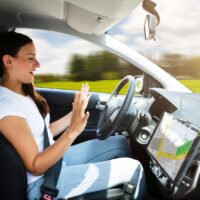Who is Liable in a Self-Driving Accident?

Self-driving cars are the way of the future. When the technology is fully developed, it’s easy to see how self-driving or autonomous vehicles will be much safer than human-operated vehicles, able to make split-second decisions without distraction, intoxication, or other human error. As we enter the year 2022, however, self-driving technology has yet to reach that ideal. In fact, the National Law Review reported that self-driving cars actually wind up in more accidents per mile driven than non-autonomous vehicles, although the accidents tend to be less severe. If a self-driving car winds up in an accident, who is to blame? What happens? Who’s liable? To learn about self-driving car accident liability in California, read on. Reach out to a savvy Southern California car crash lawyer for help recovering damages after a traffic accident.
Driverless Cars Still Have Drivers
One day, we will reach the point where self-driving cars are completely self-driving. There will be no need for someone to sit in the driver’s seat. For now, however, there’s generally a person still at the wheel. There are different levels of “autonomy” for different types of self-driving cars. The lowest level is simply a system that occasionally assists with steering and braking, while the highest level truly requires no participation by the human occupants. Most “driverless” vehicles still have someone in the driver’s seat at least partially responsible for controlling the vehicle, or at least responsible for taking over the controls in the event of an emergency. Driverless vehicles are not fully legal, and the test/pilot programs require a human driver present, just in case.
Who (or What) Caused the Crash?
In an accident involving a self-driving car, there are generally three parties that might be responsible:
- The operator sitting in the driver’s seat of a partially self-driving car
- Another driver on the road, operating a regular vehicle
- The auto manufacturer that produced and sold the self-driving vehicle
Depending on the circumstances of the case, any or all parties may be partially or totally liable. If the car was only partially self-driving and the operator made a mistake in the operation, they are liable just like any other driver. If the driver of the regular car was speeding, texting, or otherwise acting negligently, then they are at fault and liable. If, however, all drivers concerned were exercising due diligence and something in the technology failed–for example, if the automated steering mechanics malfunctioned–then the auto manufacturer may be to blame.
Determining the true cause of an accident involving a self-driving vehicle can be a complex process. The operator of the self-driving car will likely try to shift blame to the vehicle, while the auto manufacturers will try to shift blame back. The answer may be somewhere in the middle, meaning both parties are partially responsible and partially liable. A talented car crash lawyer can investigate the circumstances of the accident and find out who was to blame and how to hold them accountable.
Comparative Fault in California
Fault in a given accident, or any other personal injury incident, can fall on multiple parties. A distracted driver might have been texting while driving, at the same time a pedestrian darts across the road with no crosswalk and without checking both ways. If the vehicle was self-driving, its sensors (and the human behind the wheel) might have failed to pick up the pedestrian who unexpectedly ran in front of the vehicle.
In the event that multiple parties are at fault, injured parties may still sue, but their damages will be offset by their percentage of fault. In the examples given above, a judge or jury might find that the pedestrian was 20% at fault for jaywalking, but that the vehicle was 80% at fault for its own negligence or faulty application. If the pedestrian suffered $10,000 in damages (medical bills, pain and suffering, etc.), the most the pedestrian could recover would be $8,000 (or $10,000 minus 20%).
California is one of the few “pure” comparative fault states that allows plaintiffs to recover so long as they weren’t 100% at fault–even if the injured pedestrian was found to be 95% to blame, they could still recover 5% of their damages ($500 in the example given).
Call Morris Law Firm After a Self-Driving Car Accident in Los Angeles or Southern California
We understand that each car accident case is unique. Contact our Los Angeles personal injury attorney today to evaluate your unique car, motorcycle, truck, or pedestrian accident claim. Morris Law Firm will give you a personalized evaluation and help you figure out your legal rights and next steps.
Call us today at 747-283-1144 for a fast response or fill out our online contact form to schedule your free consultation.